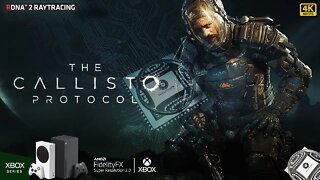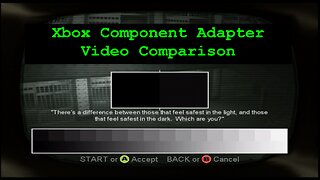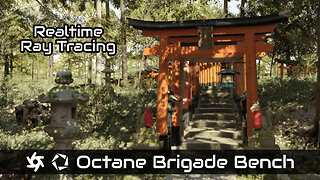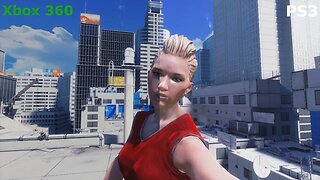The Callisto Protocol - Performance and Reflections Analysis - Xbox SX (Patch 1.6.0.0 - 12 09 2022)
Performance and Reflections Analysis of The Callisto Protocol on Xbox Series X, Patch 1.6.0.0 - 12 09 2022.
Index:
Intro 00:00
Reflections Analysis 00:37
Frame Rate Analysis 01:32
Reflections Analysis 04:19
Frame Rate Analysis 05:14
Technical dictionary for this analysis:
- AMD FidelityFX™ Super Resolution (FSR):
FidelityFX Super Resolution (FSR) is used to upsample an input image into a higher resolution. There are two versions of FSR with distinctive upscaling technique and image quality.
FSR 1 is a spatial upscaler based on the Lanczos algorithm* requiring an anti aliased lower resolution image.
FSR 2 is a temporal upscaler based on a modified Lanczos* requiring an aliased lower resolution image and utilising the temporal data (such as motion vectors and frame history) and then applies its own anti aliasing pass which replaces the game's temporal anti-aliasing solution.
Quality Preset Scale Factor Render Scale
Performance 2.0x 50.0% (e.g. for 4k: 1080p upscale to 2160p with FSR)
Balanced 1.7x 58.8% (e.g. for 4k: 1270p upscale to 2160p with FSR)
Quality 1.5x 66.6% (e.g. for 4k: 1440p upscale to 2160p with FSR)
* The Lanczos algorithm is an iterative algorithm invented by Cornelius Lanczos that is an adaptation of power methods to find eigenvalues and eigenvectors of a square matrix or the singular value decomposition of a rectangular matrix. It is particularly useful for finding decompositions of very large sparse matrices.
- Screen Space Reflections (SSR):
Screen space reflections (SSR): a more expensive technique that traces reflection rays in screen space (as opposed to world space in e.g. ray tracing). This is done for each rendered pixel of the reflected surface, using the surface normal and scene depth.
The disadvantage is that objects not captured in the rendered frame cannot appear in the reflections, which results in unresolved intersections and incomplete reflection image.
- Ray-Traced Reflections
Ray-Traced Reflections is a more accurate ray-traced solution to Screen Space Reflection technique (that traces reflection rays in screen space), ray tracing traces reflection rays in world space.
The disadvantage of the technique using ray tracing is the need for a dedicated hardware for accelerating the calculations needed to perform the feature.
- Soft Shadows Mapping
Soft shadows are typically rendered in games by using shadow mapping and Percentage Closer Filtering with a uniform kernel size. The Percentage-Closer Soft Shadows (PCSS) algorithm computes a variable kernel size based on the distance between the relative position of the receiver point, an approximation of the blocker, and the area light.
- Ray-traced Shadows
Ray-traced shadows are generated by tracing the path of rays sampled from a light source. Ray-traced shadows are more accurate than shadow-mapped shadows. All ray-traced shadows are world space shadows.
My Specs:
- Ryzen 5 5600
- 16 GB DDR4 3200
- Galax GTX 1080 Sniper White
- Elgato 4k60 Pro Mk.2
Facebook Group:
https://m.facebook.com/groups/14589692844998
-
 15:28
15:28
Lens of Truth Analysis
1 year agoThe Callisto Protocol (Day One Patch) - Xbox Series S and X
3 -
 12:17
12:17
Lens of Truth Analysis
1 year agoTech Analysis of EVIL WEST on Xbox Series S and X (tech features mentioned in the analysis in descr)
7 -
 5:44
5:44
Game Time with NateWolf
10 months ago $0.12 earnedXbox Component Adapter Video Comparison
83 -
 17:18
17:18
JSkeleton (Gaming)
1 year agoMy HONEST Review of The Callisto Protocol
7 -
 1:14
1:14
Ambocc 3D
1 year agoOctane Brigade Bench | Nvidia RTX 4090
69 -
 18:22
18:22
RoXolidProductions
2 years agoRetroTink 5x System Spotlight: OG XBox Component Video Cables Gameplay
99 -
 11:03
11:03
No Commentary Gameplay Samples
7 months agoMirror's Edge (PS3 vs Xbox 360 Graphics Comparison) -No Commentary-
35 -
 18:28
18:28
RoXolidProductions
3 years ago $0.59 earnedRetroTink 5x System Spotlight: Sega Dreamcast Composite Video Gameplay
536 -
 1:53:07
1:53:07
SJP176's Channel
5 months agoCyberpunk 2077: Ultimate Edition—Part 001—Uncut Non-commentated Casual Playthrough
112 -
 1:14:57
1:14:57
SJP176's Channel
4 months agoCyberpunk 2077: Ultimate Edition—Part 016—Uncut Non-commentated Casual Playthrough
40